Phang Nga National Parks
Phang Nga has great beaches but is also famous for its beautiful national parks. There are three marine national parks. They are the Similan Islands, the Surin Islands and Phang Nga Bay and you can read about these from our islands page. There are also three land based national parks in Phang Nga and also a short drive away in Surat Thani province is Khao Sok National Park.
Khao Sok National Park
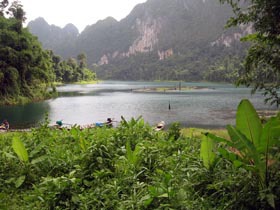 We have to start with Khao Sok National Park although it is not actually in Phang Nga province. The park is an easy 50km drive from Takua Pa into neighbouring Surat Thani province. It covers a vast 740 sq km of forest, rivers and lake. In fact the park borders four other areas of protected forest including Sri Phang Nga National Park, which altogether form a vast area of natural wilderness of more than 3,000 sq km. The verdant rainforest stretches into the distance across rolling hills. It is the oldest evergreen rainforest in the world.
We have to start with Khao Sok National Park although it is not actually in Phang Nga province. The park is an easy 50km drive from Takua Pa into neighbouring Surat Thani province. It covers a vast 740 sq km of forest, rivers and lake. In fact the park borders four other areas of protected forest including Sri Phang Nga National Park, which altogether form a vast area of natural wilderness of more than 3,000 sq km. The verdant rainforest stretches into the distance across rolling hills. It is the oldest evergreen rainforest in the world.
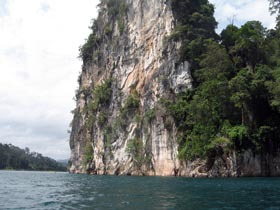 The park also includes the huge Cheow Lan Lake formed by the construction of Ratchaprapha Dam. The lake alone covers 165 sq km. It is surrounded by lush rainforest and punctuated with huge limestone karst cliffs that are a geographical feature of this area. Some of these spectacular limestone karsts tower close to 1,000 meters high. That is far higher than the same features in Phang Nga Bay.
The park also includes the huge Cheow Lan Lake formed by the construction of Ratchaprapha Dam. The lake alone covers 165 sq km. It is surrounded by lush rainforest and punctuated with huge limestone karst cliffs that are a geographical feature of this area. Some of these spectacular limestone karsts tower close to 1,000 meters high. That is far higher than the same features in Phang Nga Bay.
The species of mammals in the park include tigers, leopards, elephants, deer, Malaysian sun bear, tapir, wild boar, gibbons, macaques and bats. There are over 300 species of birds. Eagles and hawks are common sights soaring over the jungle while hornbills, kingfishers, swifts and woodpeckers fly through the trees.
The vast range of flora in the park includes bamboo, natural banana and fig trees, ferns, palms, rattan and llana vines. The park is also home to the largest flower in the world. The rafflesia is the largest and heaviest flower in the world, growing up to 90cm in diameter. They are actually a parasitic plant having no roots or leaves of their own. It plants its filaments into the llana vines for its sustenance. The flower gives off an unfortunate stench like rotting flesh that is designed to attract flies that pollinate the flowers.
The park is littered with beautiful waterfalls. There are half a dozen within easy hiking distance of the park HQ and many more deeper into the forest. There are also many caves running into the limestone cliffs.
Activities in the park include hiking along the many nature trails to view the waterfalls and wildlife. There are some nice short trails for the casual walker and some serious hikes into the jungle for the more serious trekkers.
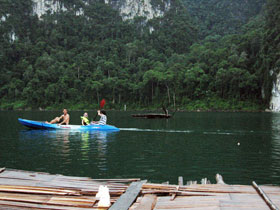 There are also canoeing and rafting trips along the meandering and sometimes bumpy rivers. You can go elephant trekking, mountain climbing or caving. There are also longtail boat tours around the wonderful scenery of the lake. There are groups of floating huts on the lake where you stay overnight and spend the day swimming in the refreshing cool waters. You can arrange guides at the park HQ or ours from any local agent near the park.
There are also canoeing and rafting trips along the meandering and sometimes bumpy rivers. You can go elephant trekking, mountain climbing or caving. There are also longtail boat tours around the wonderful scenery of the lake. There are groups of floating huts on the lake where you stay overnight and spend the day swimming in the refreshing cool waters. You can arrange guides at the park HQ or ours from any local agent near the park.
The dry season is from November to April. This is a more comfortable time to visit and the walking trails are much easier. The wet season is from May to October and the park does get a lot of rain. September and October are especially wet. It is not so easy to walk around but the waterfalls are at their best and there is more wildlife in the open.
How to Get There
The entrance to Khao Sok is down a left turn approx 50km east of Takua Pa along route 401. The turn to the lake at Ratchaprapha Dam is a further 50km along route 401 at Ban Takhun. Entrance to the national park is 200-baht for foreigners and 40-baht for Thais.
Accommodation
There is a camp site and basic park bungalows at the park HQ. You can try to pre-book bungalows by calling the department of national parks on +66 2562 0760. You will need to send payment in advance to the bank details they give you to confirm the booking. It does tend to be easier to just go to the park HQ and see what is available when you arrive.
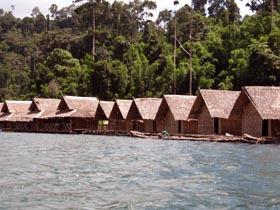 There are also floating raft houses on Cheow Lan Lake. If you go to Ratchaprapha Dam there is a park office there where you can book the raft houses and a boat. These raft houses are basic but a great experience. The very reasonable cost includes 3 meals a day at the small restaurants that adjoin the raft houses. You can swim or kayak in the lake and take tours to the local caves and trails.
There are also floating raft houses on Cheow Lan Lake. If you go to Ratchaprapha Dam there is a park office there where you can book the raft houses and a boat. These raft houses are basic but a great experience. The very reasonable cost includes 3 meals a day at the small restaurants that adjoin the raft houses. You can swim or kayak in the lake and take tours to the local caves and trails.
There are also many holiday resorts and guesthouses on the road to the park entrance. Here are just a few recommendations:
Khao Sok Paradise Resort (3 star)
Khao Sok Green Valley Resort (3 star)
Tree Top River Huts (2 star)
Khao Sok Evergreen House (2 star)
Sri Phang Nga National Park
 Sri Phang Nga National Park covers an area of 246 sq km. The park borders with Khao Sok National Park and is therefore part of a vast area of protected forest. The park is not as big, spectacular or popular as its neighbour but still has plenty to offer for a day trip or overnight stay. It is covered with verdant rain forest that covers mountainous rugged terrain and there are numerous waterfalls.
Sri Phang Nga National Park covers an area of 246 sq km. The park borders with Khao Sok National Park and is therefore part of a vast area of protected forest. The park is not as big, spectacular or popular as its neighbour but still has plenty to offer for a day trip or overnight stay. It is covered with verdant rain forest that covers mountainous rugged terrain and there are numerous waterfalls.
The wildlife includes elephants, tigers, bears, tapir, barking deer, mouse deer, gibbons, macaques, wild boar and a myriad of birds.
The main activities at this park are visiting the waterfalls and walking along the nature trails. It is also a well regarded bird watching site. The variety of oddly named bird species found here include the Drongo Cuckoo, Moustached Babbler, Banded Broadbill, Great and Helmeted Hornbills, Oriental Bay Owl and Buffy Fish Owl. Enough to keep even the keenest bird watcher satisfied.
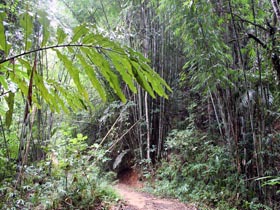 The majority of visitors head along the trail from the park HQ to Tamnang Waterfall. It is an easy 2km stroll and there are a couple of nice streams and cascades along the way. You can paddle or swim at Tamnang Waterfall and it is particularly known for the large number of fish. You can buy fish food for them and they will happily swim around your feet.
The majority of visitors head along the trail from the park HQ to Tamnang Waterfall. It is an easy 2km stroll and there are a couple of nice streams and cascades along the way. You can paddle or swim at Tamnang Waterfall and it is particularly known for the large number of fish. You can buy fish food for them and they will happily swim around your feet.
How to Get There
The entrance to Sri Phang Nga National Park is approx 25km north of Takua Pa on route 4. Entrance to the national park is 200-baht for foreigners and 40-baht for Thais.
Accommodation
There is a camp site and basic park bungalows at the park HQ. You can try to pre-book bungalows by calling the department of national parks on +66 2562 0760. You will need to send payment in advance to the bank details they give you to confirm the booking. It does tend to be easier to just go to the park HQ and see what is available when you arrive.
The park is a much smaller attraction than Khao Sok and it does not have the same selection of private resorts outside the entrance. The nearest resort is the Kuraburi Greenview Resort a few kilometres further north along route 4.
Kuraburi Greenview Resort (3 star)
Khao Lak Lamru National Park
 The Khao Lak Lamru National Park is particularly popular because the HQ is right next to Khao Lak. The park HQ is on the headland of Laem Hin Chang immediately south of Khao Lak. However this is only a small fraction of the park. The majority of the park area is inland and covers 125k sq km.
The Khao Lak Lamru National Park is particularly popular because the HQ is right next to Khao Lak. The park HQ is on the headland of Laem Hin Chang immediately south of Khao Lak. However this is only a small fraction of the park. The majority of the park area is inland and covers 125k sq km.
There is parking and a few bungalows at the park HQ. It is also possible to camp here. There is a 3km hiking trail around the headland that includes a viewpoint area and access to a secluded sandy beach.
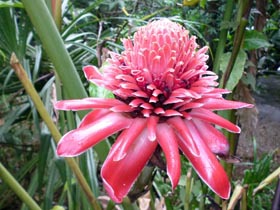 The main area of the park is actually on the other side of the road running east inland and is covered in tropical evergreen forest. Much of the forest is still pristine and in these areas you can clearly see the different canopy layers as the flora makes full use of the available breathing space. The highest mountain reaches a height of over 1,000 metres and the range of hills makes a spectacular verdant backdrop for the beaches of Khao Lak. These hills are the main source for the Takua Pa and Phang Nga rivers.
The main area of the park is actually on the other side of the road running east inland and is covered in tropical evergreen forest. Much of the forest is still pristine and in these areas you can clearly see the different canopy layers as the flora makes full use of the available breathing space. The highest mountain reaches a height of over 1,000 metres and the range of hills makes a spectacular verdant backdrop for the beaches of Khao Lak. These hills are the main source for the Takua Pa and Phang Nga rivers.
The forest is not home to the large mammals that inhabit the bigger parks such as Elephants, tigers and bears. It does have some interesting mammal species including bearcats, colugos (gliding mammals), serow and tapir. There are many birds including hornbills, eagles, minivets and doves. Reptiles include monitor lizards and snakes.
There are several nice waterfalls around the park. Chao Fa Waterfall is the most popular as it is an easy drive from Bank Niang in Khao Lak and then a short trek through the jungle. Lam Ru Waterfall is a more spectacular 5-level fall but it requires a drive to the other side of the park to Kapong on route 4090.
The main activities at this park are walking the nature trails and bird watching.
How to Get There
The Khao Lak Lamru Park HQ is on route 4 just south of Khao Lak. You drive up the hill over the headland, passed the beach viewpoint and the park HQ is on the right.
Accommodation
There is camping and a few basic park bungalows at the park HQ. You can try to pre-book bungalows by calling the department of national parks on +66 2562 0760. You will need to send payment in advance to the bank details they give you to confirm the booking.
Really most visitors are staying at one of the hotels in Khao Lak.
Khao Lampi - Thai Mueang National Park
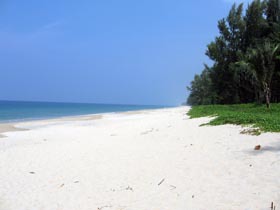 Khao Lampi - Thai Mueang National Park includes the spectacular stretch of beach at Thai Mueang and the forest and waterfall of Khao Lampi (Lampi Hill). The park comprises two separate areas that in total cover 72 sq km. The two areas of the park are not directly connected but they are not far apart.
Khao Lampi - Thai Mueang National Park includes the spectacular stretch of beach at Thai Mueang and the forest and waterfall of Khao Lampi (Lampi Hill). The park comprises two separate areas that in total cover 72 sq km. The two areas of the park are not directly connected but they are not far apart.
Thai Mueang Beach is a spectacular 14km straight stretch of sand that runs from the small town of Thai Mueang north all the way to the river outlet at Tablamu Naval Base. The beach is particularly known as a nesting area for turtles that come ashore on full moon nights from November to February.
The entire beach is generally very quiet and sometimes totally deserted. The beach is golden powdery sand and is lined with casuarina trees and mangroves. The beach can slope quite steeply into the sea and during the rainy season there are dangerous currents. Behind the beach is a brackish waterway and mangrove swamp that is sourced from Lampi Hill.
There is also a 2.7 sq km coral reef offshore that was only recently discovered. It is 400-800 meters offshore and ranges in depth from 6m to 10m. It is possible to arrange scuba or snorkelling trips.
The hill range area of the park is inland on the other side of route 4. It is covered in tropical rainforest. And the highest point is 622 meters. Mammal species recorded in the park include sun bear, tapir, serow, civet cats and macaque monkeys. Bird species include eagles, woodpeckers, kites, kingfishers and cormorants.
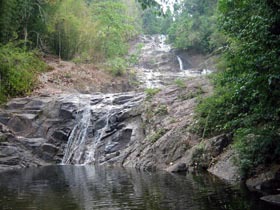 The most popular attraction in the forest area is Lampi Waterfall. It is a 3-level fall that drops a total of 40-meters. There is a drop pool at the base where you can take a refreshing swim. There are usually a few locals selling refreshments and there is a short nature trail to the top of the falls. The entrance to the falls is about 10km south of Thai Mueang.
The most popular attraction in the forest area is Lampi Waterfall. It is a 3-level fall that drops a total of 40-meters. There is a drop pool at the base where you can take a refreshing swim. There are usually a few locals selling refreshments and there is a short nature trail to the top of the falls. The entrance to the falls is about 10km south of Thai Mueang.
How to Get There
Thai Mueang Beach can be reached from Thai Mueang Town on route 4. Just follow the turn west to the beach. The forest area is best entered at Lampi Waterfall some 10km south of Thai Mueang Town. Entrance to the national park is 100-baht for foreigners and 40-baht for Thais.
Accommodation
There are a few park houses at the beach. You can try to pre-book bungalows by calling the department of national parks on +66 2562 0760. You will need to send payment in advance to the bank details they give you to confirm the booking.
There are no major hotels in the area but there are a few private budget guesthouses in Thai Mueang Town. An alternative option is to camp at the very pleasant Sawasdee Lagoon.
Sawasdee Lagoon Camping (1 star)

